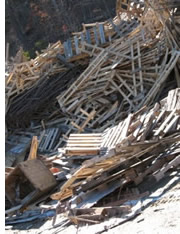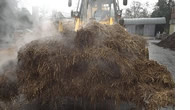What's Biomass?— Biomass is any material from a biological source. Sustainable biochar production uses crop residues, non-commercial wood and wood waste, manure, solid waste, non-food energy crops, construction scraps, yard trimmings, methane digester residues or grasses. Biomass for bio-fuels or biochar needs to be excess—beyond what should be left on-site for maintaining forest and  agricultural cropland health. Biomass that can be converted to a higher purpose, such as for food or animal feed, shouldn't be used for biochar production. In the U.S., sustainable production of biomass for energy use is strongly emphasized.
agricultural cropland health. Biomass that can be converted to a higher purpose, such as for food or animal feed, shouldn't be used for biochar production. In the U.S., sustainable production of biomass for energy use is strongly emphasized.
Thermal Conversion of Biomass— Biochar is produced during pyrolysis or gasification - the super heating and thermal conversion of biomass in limited oxygen at high temperatures (350-700°C) in a specially designed furnace that captures all of the emissions produced. Conversely, conventional combined heat and power (co-gen) ovens burn biomass emitting smoke, greenhouse gases, and only make ash.
 Valuable Waste—Biomass, typically worthless but costly to get rid of, is now a valuable resource for biochar production. Tipping fees, overloading landfills, open burning and pollution are avoided because biomass becomes an efficient, indigenous, sustainable and value-added product for urban, rural agriculture and forest communities. Depending on size and capacity of the pyrolysis furnace, heat and power are generated and available as an alternative clean energy source for family-sized residential, commercial, industrial and community applications.
Valuable Waste—Biomass, typically worthless but costly to get rid of, is now a valuable resource for biochar production. Tipping fees, overloading landfills, open burning and pollution are avoided because biomass becomes an efficient, indigenous, sustainable and value-added product for urban, rural agriculture and forest communities. Depending on size and capacity of the pyrolysis furnace, heat and power are generated and available as an alternative clean energy source for family-sized residential, commercial, industrial and community applications.
Biomass Converted to Renewable Energy— During pyrolysis, biochar is only one of the many valuable bioenergy and bioproducts produced. Volatile gases (methane, carbon monoxide and other combustible gases), hydrocarbons and most of the oxygen in the biomass are burned or driven off, leaving carbon-enriched biochar. All of the emissions (better known as air pollution and greenhouse gases) typically associated with burning biomass are captured and condensed into liquid fuels like bio-oil, industrial chemicals, or syngas (synthetic gas). These products can be containerized for sale, for future use at the production facility or used on-site as part of the process for energy production.
Carbon Credits for Clean Energy and Sequestration— Carbon credits are valuable assets for sale or trade in the offset and cap-and-trade markets. Companies that emit more CO2 than they are allowed can purchase (or trade) credits from entities that produce clean energy or sequester carbon dioxide. Biochar is not currently a listed category in the offset or cap-and-trade market (but Europeans are using it in voluntary markets). In November 2008 the concept was presented at the United Nations Framework Convention on Climate Change. Negotiations are underway for a more complete presentation and potential acceptance at the next international climate change convention in Copenhagen in December 2009.
Click here for a printer friendly version.